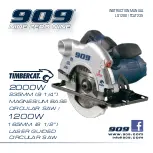
GB
- 27 -
8.1.2. Cutting narrow workpieces (Fig. 18)
Be sure to use a push stick (3) when making
longitudinal cuts in workpieces smaller than 120
mm in width. A push block is supplied with the
saw! Replace a worn or damaged push stick im-
mediately.
8.1.3.Cutting extremely narrow workpieces
(Fig. 19)
•
Be sure to use a push block when making
longitudinal cuts in very narrow workpieces
with a width of 30 mm and less.
•
The low guide face of the parallel stop is best
used in this case.
•
There is no push block supplied with the
saw! (Available from your specialist dealer).
Replace the push block without delay when it
becomes worn.
8.1.4. Making bevel cuts (Fig. 16/20)
Bevel cuts must always be used using the parallel
stop (7).
•
Set the blade (4) to the desired angle. (See
7.5.)
•
Set the parallel stop (7) in accordance with
the workpiece width and height (see 7.3.1)
•
Carry out the cut in accordance with the work-
piece width (see 8.1.1., 8.1.2 and 8.1.3.)
8.1.5. Making cross cuts (Fig. 21)
•
Slide the cross stop (21) into one of the
grooves (21) in the table and adjust to the
required angle. (See 7.4.) If you also want to
tilt the blade (4), use the groove (21) which
prevents your hand and the cross stop from
making contact with the blade guard.
•
Press the workpiece firmly against the cross
stop (14).
•
Switch on the saw.
•
Push the cross stop (14) and the workpiece
toward the blade in order to make the cut.
•
Warning!
Always hold the guided part of the workpiece.
Never hold the part which is to be cut off.
•
Push the cross stop (14) forward until the
workpiece is cut all the way through.
•
Switch off the saw again. Do not remove the
offcut until the blade has stopped rotating.
9. Replacing the power cable
Danger!
If the power cable for this equipment is damaged,
it must be replaced by the manufacturer or its
after-sales service or similarly trained personnel
to avoid danger.
10. Cleaning, maintenance and
ordering of spare parts
Danger!
Always pull out the mains power plug before star-
ting any cleaning work.
10.1 Cleaning
•
Keep all safety devices, air vents and the
motor housing free of dirt and dust as far as
possible. Wipe the equipment with a clean
cloth or blow it with compressed air at low
pressure.
•
We recommend that you clean the device
immediately each time you have finished
using it.
•
Clean the equipment regularly with a moist
cloth and some soft soap. Do not use
cleaning agents or solvents; these could at-
tack the plastic parts of the equipment. Ensu-
re that no water can seep into the device. The
ingress of water into an electric tool increases
the risk of an electric shock.
10.2 Carbon brushes
In case of excessive sparking, have the carbon
brushes checked only by a quali
fi
ed electrician.
Danger!
The carbon brushes should not be rep
laced by anyone but a quali
fi
ed electrician.
10.3 Maintenance
There are no parts inside the equipment which
require additional maintenance.
Anl_TC_TS_2025_2_ECO_SPK9.indb 27
Anl_TC_TS_2025_2_ECO_SPK9.indb 27
18.12.2017 08:46:53
18.12.2017 08:46:53
















































